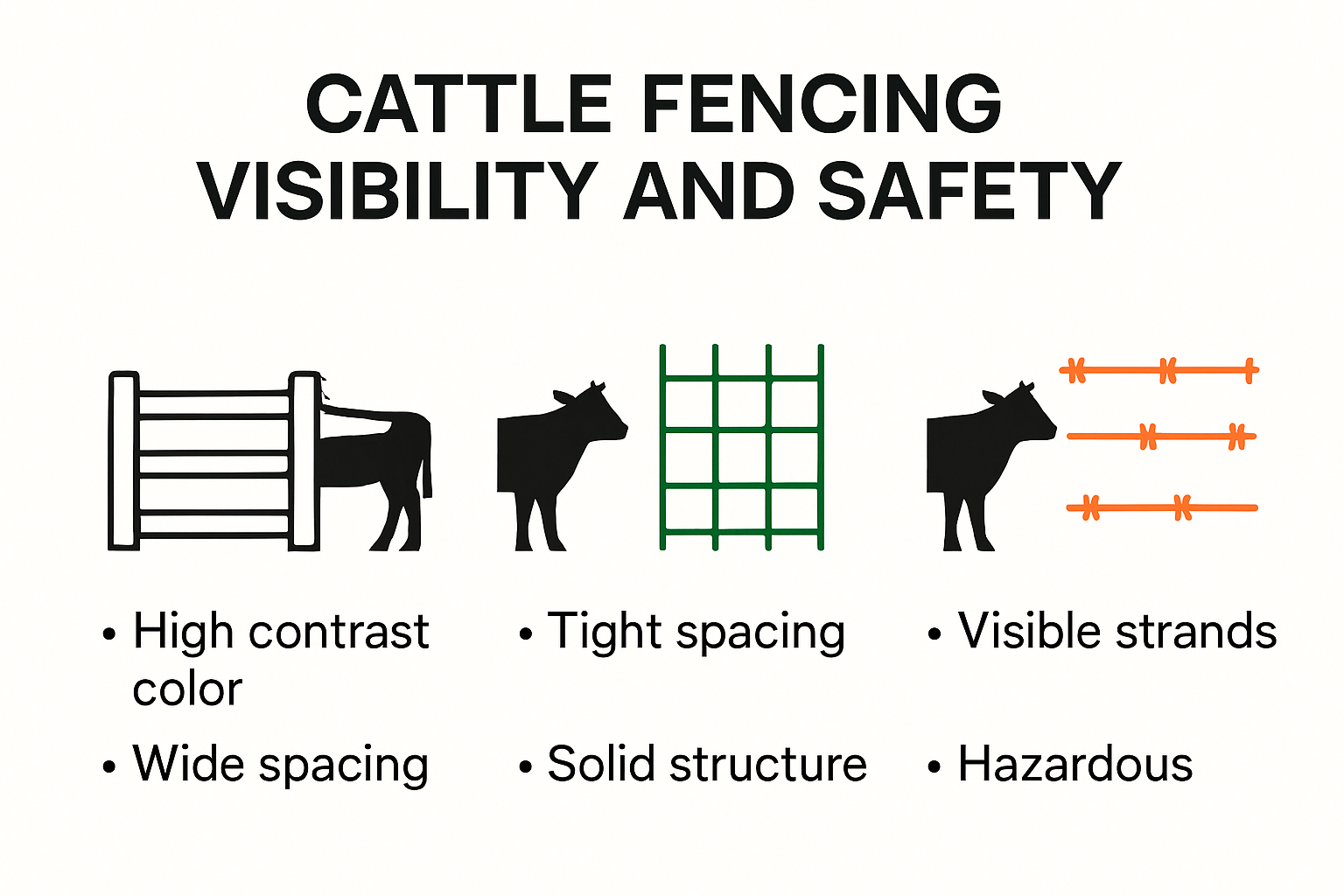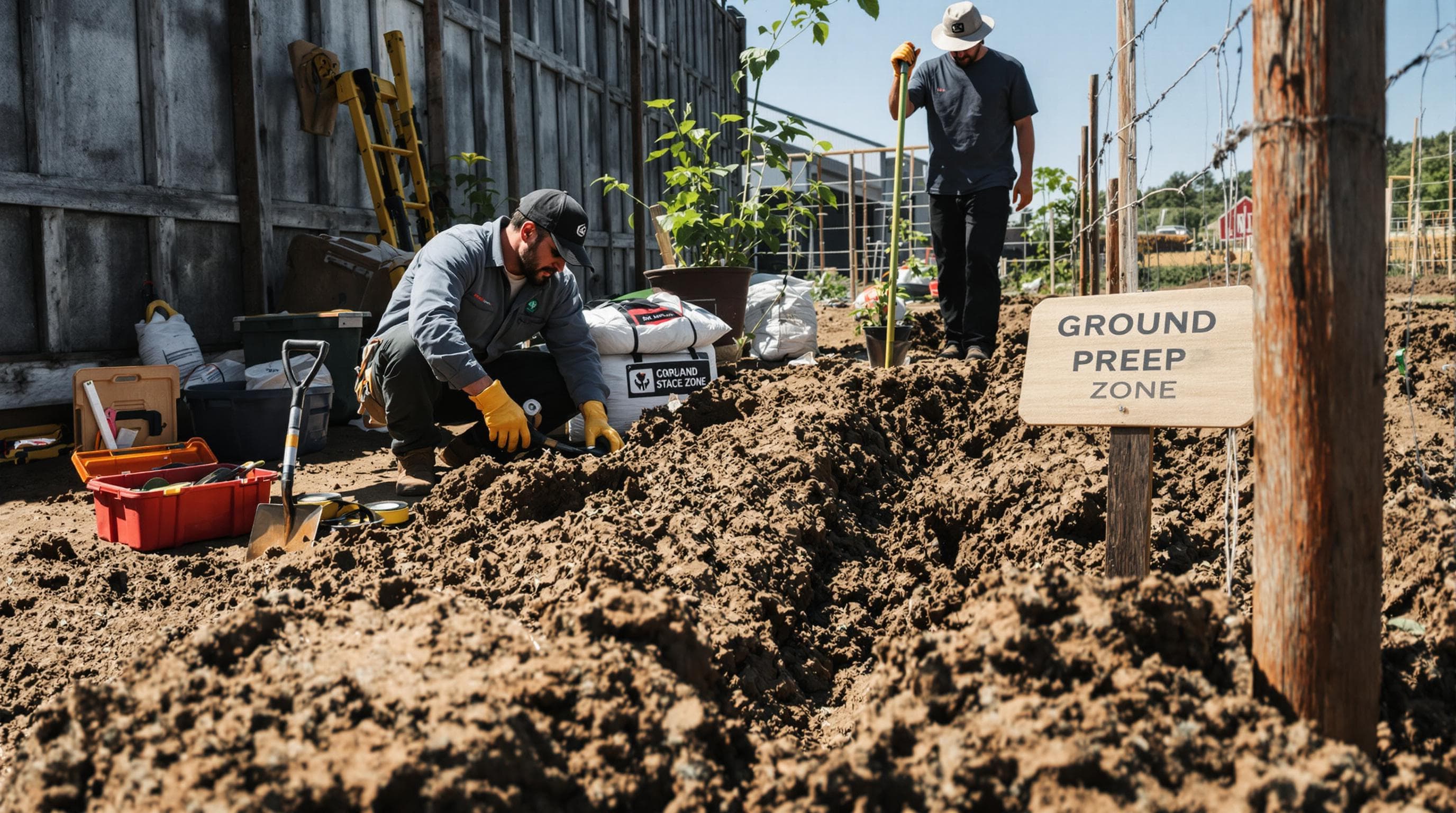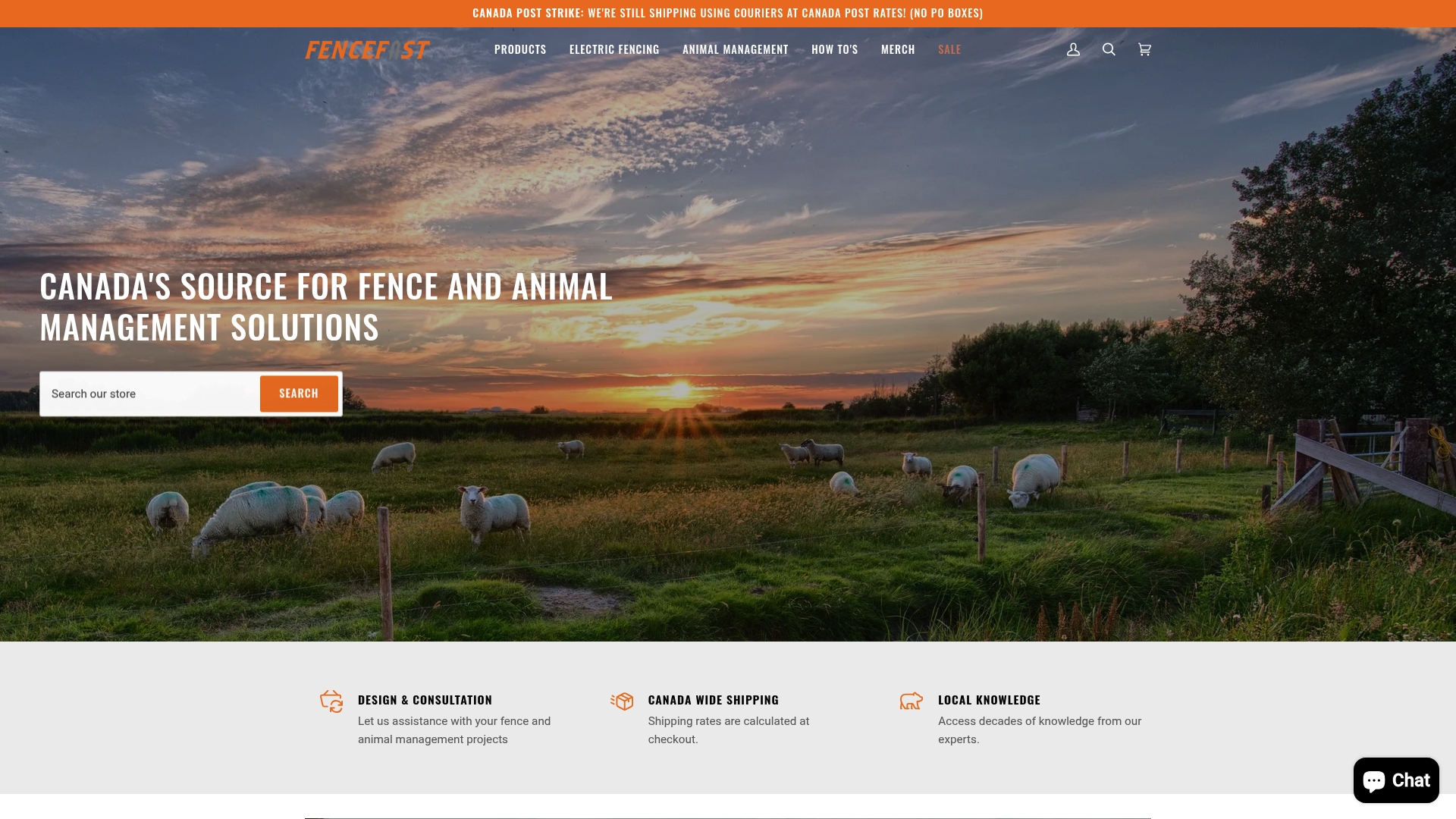Choosing fencing for cattle is a big decision for any farm and the differences in quality and durability can make or break your entire operation. Most people expect a sturdy fence to guarantee safety but even the toughest material can fail if you use the wrong wire gauge or ignore the landscape. The real surprise is that cattle are far less likely to challenge a fence they can see clearly and research shows that good visibility is just as vital as strength for keeping herds contained.
Table of Contents
Quick Summary
| Takeaway | Explanation |
| Strength and Durability are Crucial | Use high tensile steel wire with recommended gauges between 12.5 to 15.5 to withstand the stress from large cattle and harsh environments. |
| Visibility Enhances Containment | Ensure that wire spacing and color contrast are effective for cattle recognition, and consider smooth edges to prevent injuries. |
| Proper Installation is Key | Focus on ground preparation and post depth, typically 24 to 36 inches, to ensure fence stability and longevity. |
| Ongoing Maintenance is Essential | Conduct regular inspections for damage and proper tension to extend the life of the fence and minimize repair costs. |
| Evaluate Long-Term Costs | Assess not just initial costs, but consider maintenance and longevity for determining the true value of fencing options. |
Key Features of the Best Fencing for Cattle
Selecting the best fencing for cattle requires understanding critical characteristics that ensure livestock safety, durability, and effective containment. The right fencing protects your investment by preventing cattle from escaping while keeping potential predators and external threats at bay.
Strength and Durability Considerations
Cattle fencing must withstand significant physical stress from large animals weighing between 1,000 to 1,500 pounds. Agricultural Engineering Research suggests that ideal cattle fencing should resist impacts, maintain structural integrity, and endure harsh environmental conditions. Key strength factors include material quality, wire gauge thickness, and post stability.
Steel wire fencing with high tensile strength provides superior performance. Recommended wire gauges range from 12.5 to 15.5, offering the right balance between flexibility and resistance. Cattle can exert substantial pressure against fencing, so materials must be robust enough to prevent breaking or permanent deformation.
Visibility and Safety Features
Proper visibility plays a crucial role in cattle fencing effectiveness. Animal Behavior Research Institute indicates that cattle are more likely to respect fence boundaries when they can clearly perceive physical barriers. Horizontal wire spacing, color contrast, and post visibility contribute to creating psychological and physical containment.

Safety design elements are paramount. Smooth wire edges prevent potential injury, while adequate tension prevents sagging that might entrap animals. Electric fencing options provide an additional deterrent, creating a psychological barrier that discourages cattle from attempting to breach the fence.
Terrain and Environmental Adaptability
The best cattle fencing adapts to diverse terrain and environmental challenges. Different landscapes require specialized fencing solutions. Flat pastures demand different approaches compared to hilly or rocky terrains. Fence design must account for potential ground movement, seasonal temperature variations, and potential wildlife interactions.
Corrosion resistance becomes critical in regions with high moisture or salt exposure. Galvanized steel and polymer-coated wires offer extended durability. Installation techniques like proper post setting depth and using ground anchors enhance overall fence stability and longevity.
Ultimately, selecting the best fencing for cattle involves balancing multiple factors: material strength, animal safety, environmental adaptability, and long-term performance. Careful evaluation of these key features ensures robust livestock management and protection.
Comparing Popular Cattle Fencing Types
Choosing the right fencing type for cattle requires understanding the unique characteristics and performance of different materials and designs. Each fencing option presents distinct advantages and challenges that directly impact livestock management and farm operational efficiency.
Wire Fencing Varieties
Wire fencing remains the most prevalent option for cattle containment. Agricultural Extension Services categorize wire fencing into several critical types. Barbed wire offers an economical solution, featuring sharp wire points that discourage cattle from pushing through fence lines. High tensile wire provides superior strength and flexibility, allowing greater spans between support posts.
Woven wire fencing presents another robust option, featuring tightly interlocked horizontal and vertical wires. This design creates a solid barrier preventing smaller animals from passing through while providing excellent containment for cattle. The mesh configuration distributes physical stress more evenly, reducing potential weak points in the fence structure.
Electric Fencing Options
Livestock Management Research indicates electric fencing has gained significant popularity among cattle producers. Electric fence systems create a psychological barrier that trains animals to respect boundary lines. The minimal physical infrastructure required makes installation faster and more cost-effective compared to traditional wire fencing.
Modern electric fencing technologies offer multiple configuration options. Solar-powered systems provide sustainable energy solutions for remote pastures, while battery-powered units offer flexibility in temporary or rotational grazing setups. Wire tension and proper grounding remain critical for maintaining consistent electrical flow and deterrent effectiveness.
Specialized Fencing Considerations
Terrain and specific agricultural requirements influence fencing selection. Rough landscapes might demand more robust post settings and specialized wire configurations. Farm Engineering Experts recommend evaluating local environmental conditions when selecting fencing materials.
Composite and polymer-based fencing solutions are emerging as innovative alternatives. These materials offer corrosion resistance, reduced maintenance requirements, and enhanced durability in challenging climatic conditions. While typically more expensive upfront, their long-term performance can offset initial investment costs.
Consider our comprehensive fencing guide for more detailed insights into selecting the perfect fencing solution for your specific cattle management needs. Understanding the nuanced differences between fencing types empowers farmers to make informed decisions that balance cost, durability, and livestock safety.
Below is a comparison table summarizing the main cattle fencing types, highlighting their key characteristics, advantages, and challenges to help guide your selection.
| Fencing Type | Key Characteristics | Advantages | Challenges |
| Barbed Wire | Sharp wire points, simple structure | Low initial cost, effective deterrent | Can cause injuries, moderate durability |
| High Tensile | Strong, flexible steel wire, spaced posts | Fewer posts needed, resists breakage | Requires proper tensioning, tricky repair |
| Woven Wire | Interlocked mesh, smaller openings | Excellent containment, durable | Higher cost, more labor-intensive |
| Electric | Uses electrified wires; solar/battery-powered options | Psychological barrier, flexible install | Needs constant power, less physical block |
| Composite/Polymer | Corrosion-resistant synthetic materials | Low maintenance, long lifespan | Higher upfront expense |
Installation Tips and Maintenance for Long-Lasting Fences
Successful cattle fencing goes beyond initial construction. Proper installation and ongoing maintenance determine the longevity, effectiveness, and overall performance of your fence, protecting your livestock investment and ensuring optimal farm management.
Strategic Installation Fundamentals
Mississippi State University Extension emphasizes that successful fence installation begins with meticulous planning. Ground preparation plays a critical role in fence stability. This involves clearing vegetation, ensuring proper drainage, and creating a level surface that supports consistent post placement.

Post selection and placement represent crucial technical considerations. Recommended post depths vary depending on soil type and fence height. Typically, fence posts should be set 24 to 36 inches deep, with additional anchoring in loose or sandy soils. Using concrete footings or specialized ground anchors enhances overall structural integrity and prevents post shifting over time.
Tension and Alignment Techniques
Agricultural Fencing Research indicates that proper wire tension is fundamental to fence performance. Uneven or overly loose wire compromises fence effectiveness and increases potential livestock escape risks.
Professional installation requires uniform wire tension across all fence sections. Specialized tensioning tools help achieve consistent wire tightness. Periodic tension checks during initial installation and subsequent maintenance periods prevent sagging, reduce material stress, and maintain fence structural integrity. Electric fencing systems demand additional attention to wire conductivity and grounding techniques.
Ongoing Maintenance Strategies
University of Wisconsin Extension recommends comprehensive seasonal maintenance to extend fence lifespan. Regular inspections help identify potential issues before they become significant problems. Key maintenance activities include checking for:
-
Wire corrosion or damage
-
Loose or leaning posts
-
Vegetation interference
-
Electrical system functionality
-
Animal damage or wear points
Seasonally adjusting fence components prevents long-term degradation. Winter conditions may require additional bracing, while summer vegetation growth necessitates trimming around fence lines. Proactive maintenance reduces repair costs and ensures continuous livestock containment.
Check out our detailed fence maintenance guide for comprehensive strategies tailored to your specific fencing system. Investing time in proper installation and consistent maintenance transforms your fence from a simple boundary marker into a reliable livestock management tool.
The following checklist table summarizes essential ongoing fence maintenance activities, helping you track what needs to be inspected or addressed to keep your cattle fencing effective year-round.
| Maintenance Task | Recommended Frequency | Importance | Status (✓/✗) |
| Inspect wire for damage/corrosion | Monthly/After storms | High | |
| Check post stability | Monthly | High | |
| Remove vegetation near fence | Bi-monthly/summer | Medium | |
| Test electric fence functionality | Monthly | High | |
| Look for animal-induced wear | Monthly | Medium | |
| Tighten wires as needed | Quarterly | High | |
| Add winter bracing if necessary | Pre-winter | Medium |
Cost Considerations and Choosing the Right Fence
Selecting the optimal cattle fence involves more than initial price comparison. A comprehensive understanding of long-term expenses, performance, and specific farm requirements guides smart investment decisions that balance affordability with livestock protection.
Material Cost Analysis
Virginia Cooperative Extension highlights that total fencing costs extend beyond raw material expenses. Initial investment typically includes materials, labor, installation equipment, and additional components like gates and corner braces. Different fencing types present varied cost structures.
Barbed wire fencing represents the most economical upfront option, with costs ranging from $0.25 to $1.50 per linear foot. High tensile wire systems cost slightly more, approximately $1.50 to $3.00 per foot, but offer longer durability and reduced maintenance expenses. Woven wire fencing represents the highest initial investment, ranging from $3.50 to $7.00 per linear foot, but provides superior animal containment and longevity.
Long-Term Value Considerations
Agricultural Economic Research demonstrates that initial price does not always indicate true fence value. Factors like maintenance frequency, replacement intervals, and potential livestock loss significantly impact overall economic performance.
Electric fencing systems provide an interesting cost-benefit analysis. While installation costs can be comparable to traditional wire fencing, reduced maintenance and enhanced livestock management capabilities create substantial long-term savings. Operational efficiency becomes a critical evaluation metric beyond simple material expenses.
Budgeting and Financial Planning
Successful fence selection requires comprehensive financial planning. Farmers should consider additional expenses including:
-
Professional installation services
-
Annual maintenance costs
-
Potential repair and replacement expenses
-
Performance impact on livestock productivity
Regional variations in material costs, labor rates, and environmental conditions further complicate financial calculations. Consulting local agricultural extension services or experienced fencing professionals can provide tailored insights specific to your operational context.
Explore our comprehensive fencing cost calculator to develop a precise budget for your cattle fencing project. Understanding the nuanced economics of fencing empowers farmers to make informed decisions that protect both livestock and financial investments.
Frequently Asked Questions
What is the best type of fencing for cattle?
The best type of fencing for cattle is typically high tensile wire fencing, as it offers strength and flexibility. Woven wire fencing is also a good option for superior containment, while electric fencing can create psychological barriers that deter cattle from escaping.
How deep should fence posts be set for cattle fencing?
Fence posts should be set 24 to 36 inches deep to ensure stability and prevent shifting. Proper post depth is crucial for maintaining the integrity of the fence, especially in areas with loose or sandy soil.
How often should cattle fencing be maintained?
Cattle fencing should be inspected regularly, ideally on a monthly basis, and after storms. Regular maintenance tasks include checking for wire damage, ensuring post stability, and trimming vegetation around fence lines to prevent interference.
What are the cost considerations when choosing cattle fencing?
When selecting cattle fencing, consider both the initial material costs and long-term value. Barbed wire is typically the most economical upfront option, while woven wire and high tensile options may have higher initial costs but provide longer lifespan and reduced maintenance expenses.
Give Your Cattle the Protection They Deserve with FenceFast.ca
Choosing the right fence is critical for keeping your livestock secure, and the article above highlights just how much depends on using tough, visible, and well-maintained fencing. Problems like weak wire gauge, poor visibility, or improper installation put your herd and investment at risk. When you are managing large animals in Canada’s changing weather, you need solutions that do not just work once, but last season after season. With so many options and technical details around strength and durability, it can be overwhelming to select the right products for your operation.

Visit FenceFast.ca today to find everything you need for reliable cattle fencing and farm management. Shop quality fencing wire, electric fence systems, and dependable installation tools, all carefully curated for Canadian farmers. Take advantage of our expert design advice and simple online ordering so you can secure your livestock, protect your assets, and focus on running your farm. Looking for in-depth guides and maintenance tips? Explore more helpful resources for livestock fencing and let FenceFast.ca help you build a fence you can trust. Act now to ensure your fences are ready for calving season and keep cattle safely contained year-round.
Recommended
-
[
200 WATTS 12 VOLTS MONOCRYSTALLINE SOLAR BUNDLE KITS – FenceFast Ltd.
](https://fencefast.ca/products/200-watts-12-volts-monocrystalline-solar-bundle-kits)
-
[
Gallagher Earth Ground Stake KIWITAH – FenceFast Ltd.
](https://fencefast.ca/products/gallagher-kiwitah-ground-stake)
-
[
Gallagher Vine-Line Wire Connector – FenceFast Ltd.
](https://fencefast.ca/products/gallagher-vine-line-wire-connector)
-
[
Gallagher S200 Portable Solar Fence Energizer 2.0 joules – FenceFast Ltd.
](https://fencefast.ca/products/gallagher-solar-fence-energizer-s200)

